All creatures great and small: How the environment controls traits

Until now scientists have believed that the variations in traits such as our height, skin colour, tendency to gain weight or not, intelligence, tendency to develop certain diseases, etc., all of them traits that exist along a continuum, were a result of both genetic and environmental factors. But they didn't know how exactly these things worked together. By studying ants, McGill researchers have identified a key mechanism by which environmental (or epigenetic) factors influence the expression of all of these traits, (along with many more).
They believe that, by identifying a key gene for each trait and how it is affected epigenetically (by the environment), it is potentially possible to influence the degree of its expression - and so create variation in how specific traits are expressed. It's a bit like an artist adding more or less white paint to black to create a palette of shades of gray. In effect, it is the discovery of the mechanism through which the environment interacts with specific genes, revealing environmental factors as an equal partner in determining complex traits.
A McGill team led by Profs. Moshe Szyf and Ehab Abouheif, from the McGill's Departments of Pharmacology and Therapeutics, and Biology respectively, has clearly identified a mechanism by which epigenetic factors - how the environment affects the expression of a single gene - have an overarching effect in creating quantitative variation in these kinds of complex traits.
The researchers arrived at this conclusion by conducting epigenetic experiments on ants from the species Camponotus floridanus (better known as the Florida carpenter ant). Because there is little genetic influence in determining size variation of workers in a colony (they are on average 75 per cent related) and because their genome has already been sequenced it was possible for the researchers to focus on the effects of epigenetic factors in creating variations in size.
The enviro-genetics of a superhero: Ant Man
By increasing the degree of DNA methylation (a biochemical process that controls the expression of certain genes - a bit like a dimmer can turn a light up or down) of a gene involved in controlling growth called Egfr, they were able to create a spectrum of worker ant sizes despite the lack of genetic difference between one ant and the next. Essentially, the researchers found that the more methylated the gene, the larger the size of the ants.
"Basically, what we found was a kind of cascading effect. By modifying the methylation of one particular gene, that affects others, in this case the Egfr gene, we could affect all the other genes involved in cellular growth," says Sebastian Alvarado, the McGill PhD who is the co-first author on the study that was published today in Nature Communications. "We were working with ants, but it was a bit like discovering that we could create shorter or taller human beings."
Finding the right gene to work on
"In the case of growth in ants, it was the Egfr gene which was determinant," says Rajendhran Rajakumar, co-first author of the paper. "But for other complex traits, whether they are involved in the growth of cancer cells in humans or fat cells in chickens, what we now know is that once we have discovered, in each case, the key genetic position that is affected by epigenetic factors we can then influence how much or how little of the gene is expressed with potentially very far-reaching results."
"It's a discovery that completely changes our understanding of how human variation comes to be," says Abouheif. "So many human traits, whether they are intelligence, height, or vulnerability to diseases such as cancer, exist along a continuum. If, as we believe, this epigenetic mechanism applies to a key gene in each area, the change is so enormous that it's hard to even imagine right now how it will influence research in everything from health to cognitive development to farming."
More information: "Epigenetic variation in the Egfr gene generates quantitative variation in a complex trait in ants." Nature Communications 6, Article number: 6513 doi:10.1038/ncomms7513
Journal information: Nature Communications
Provided by McGill University



















